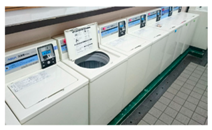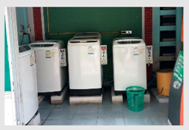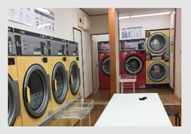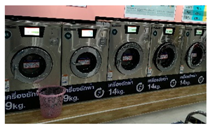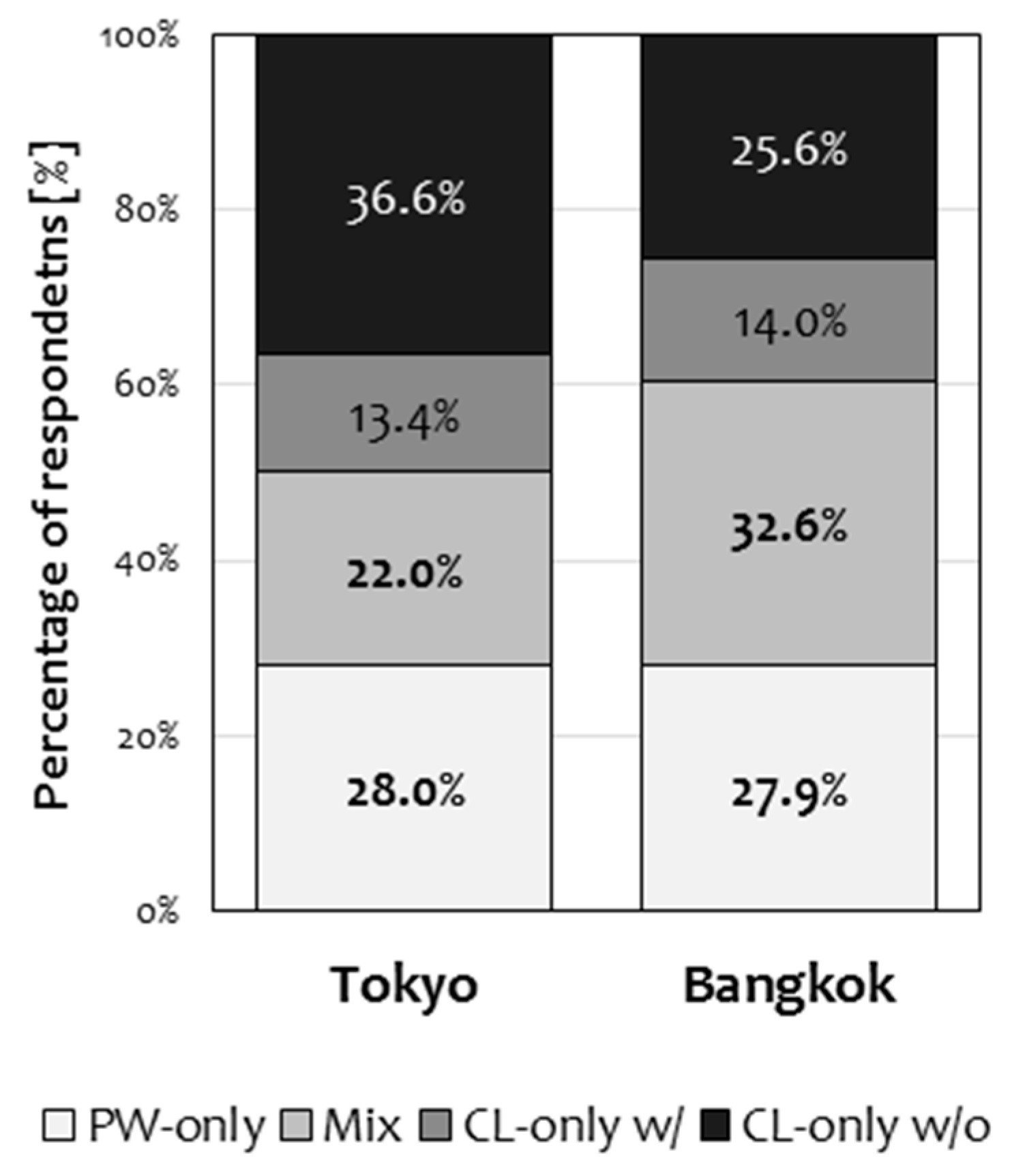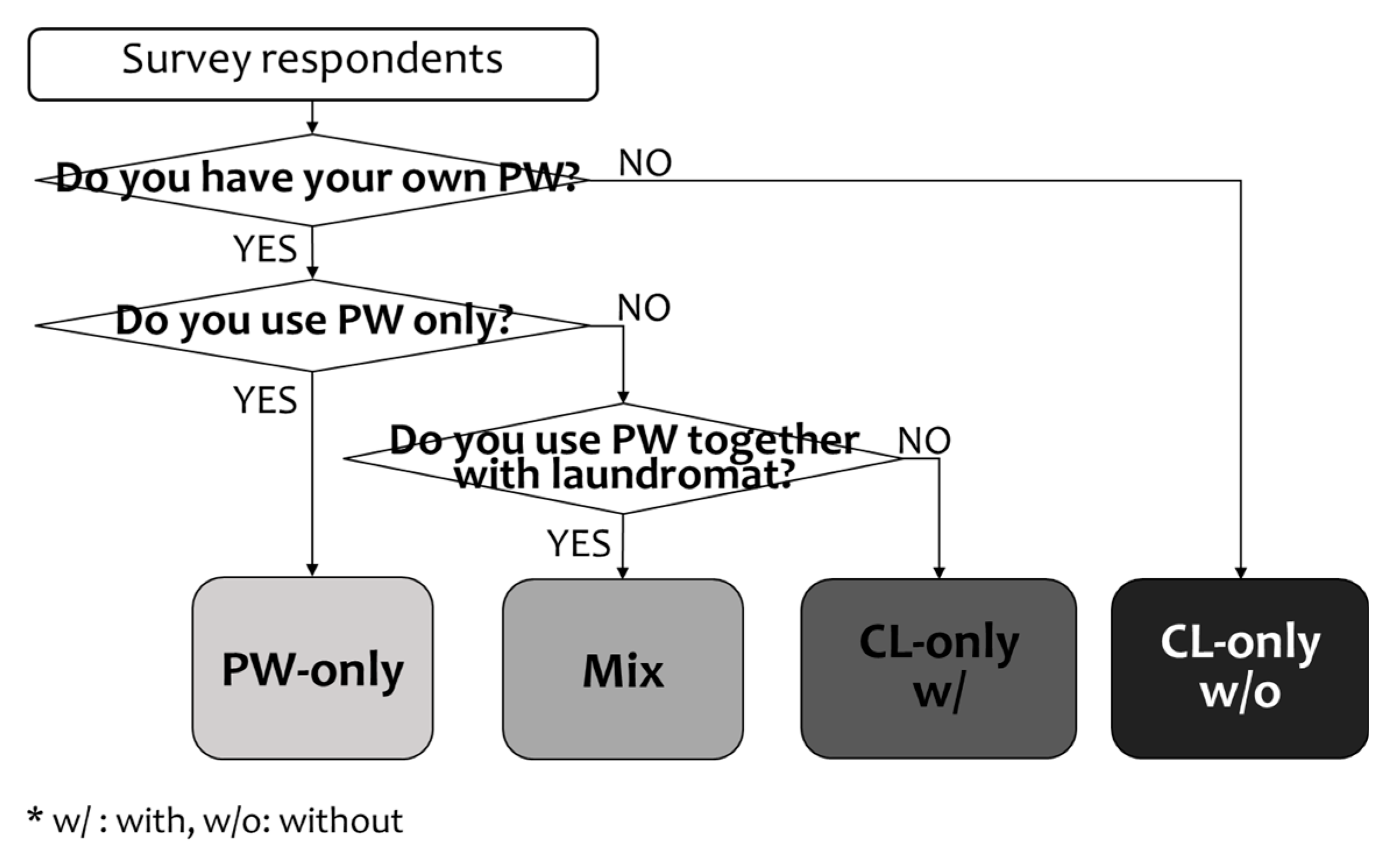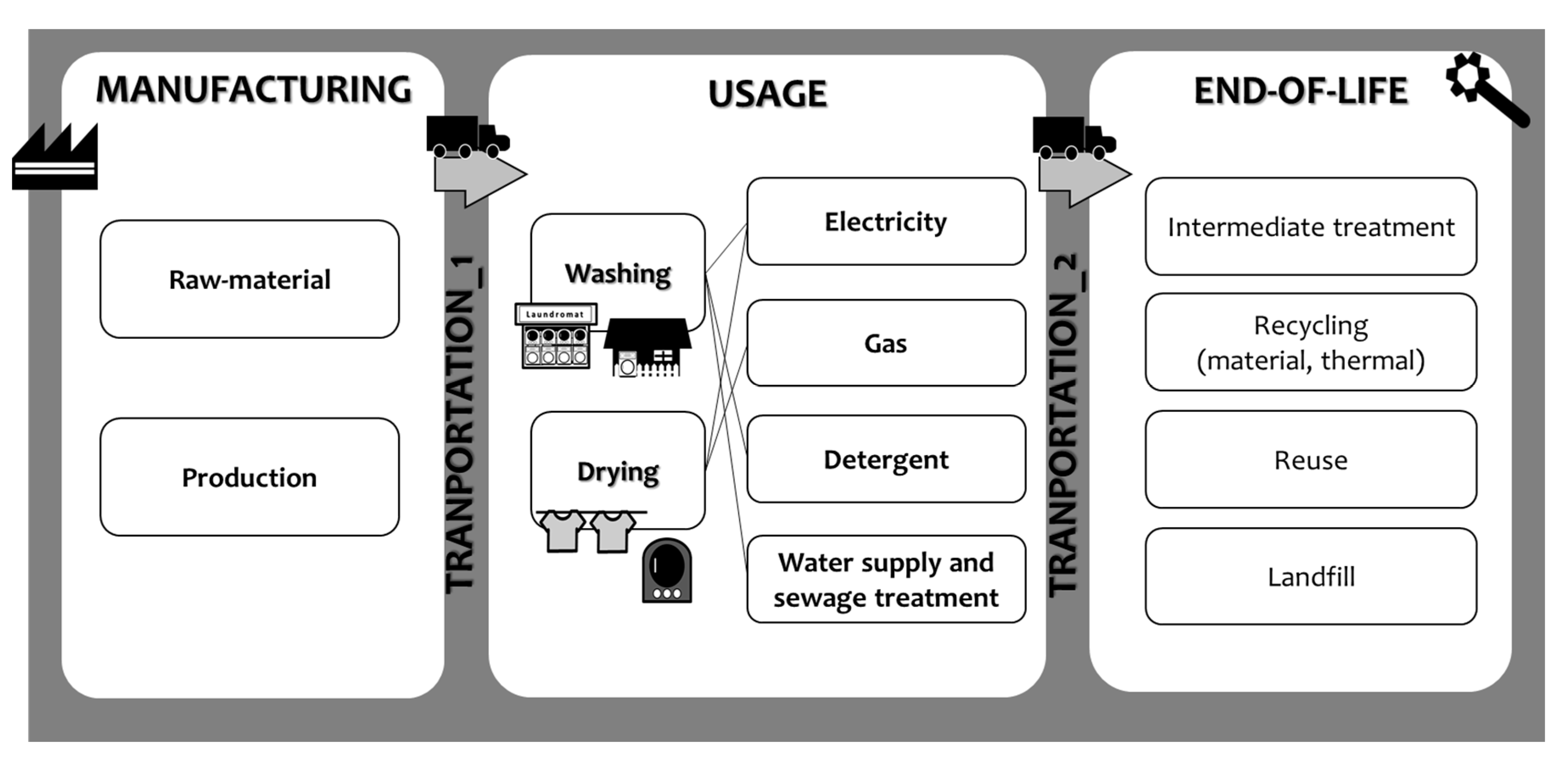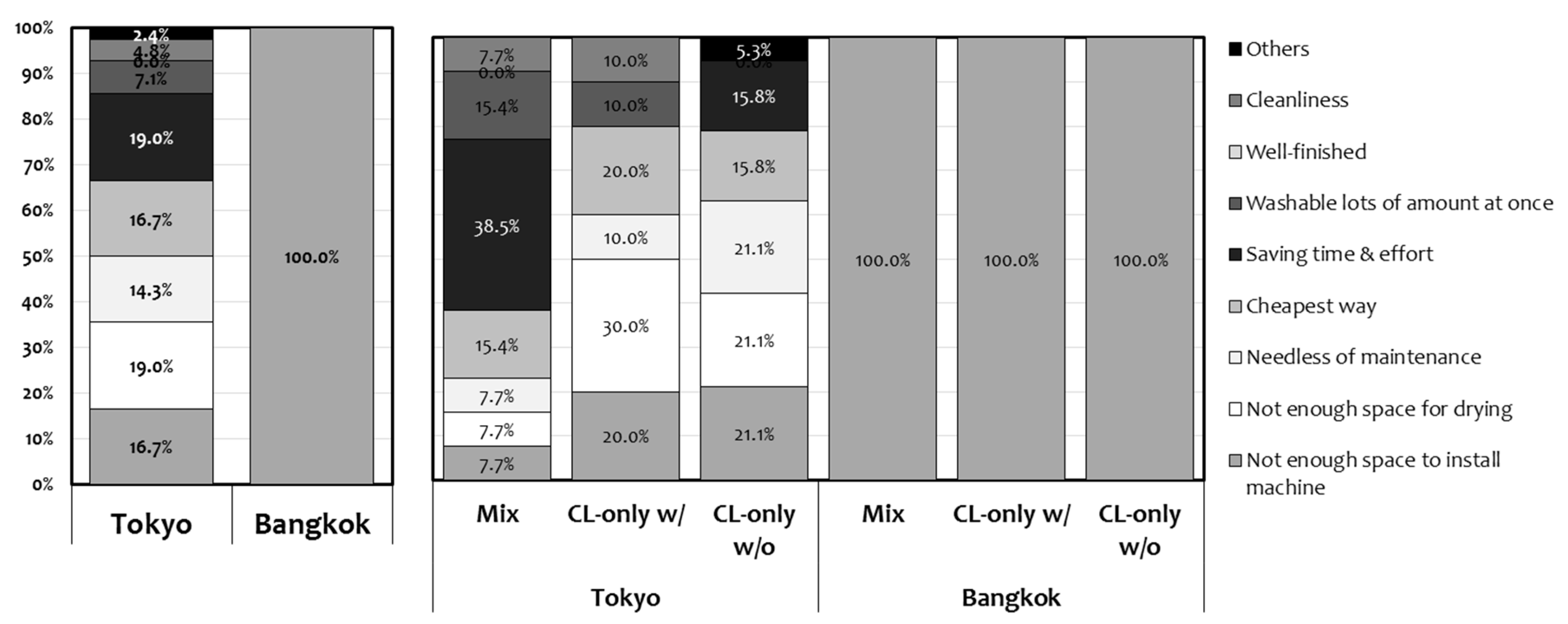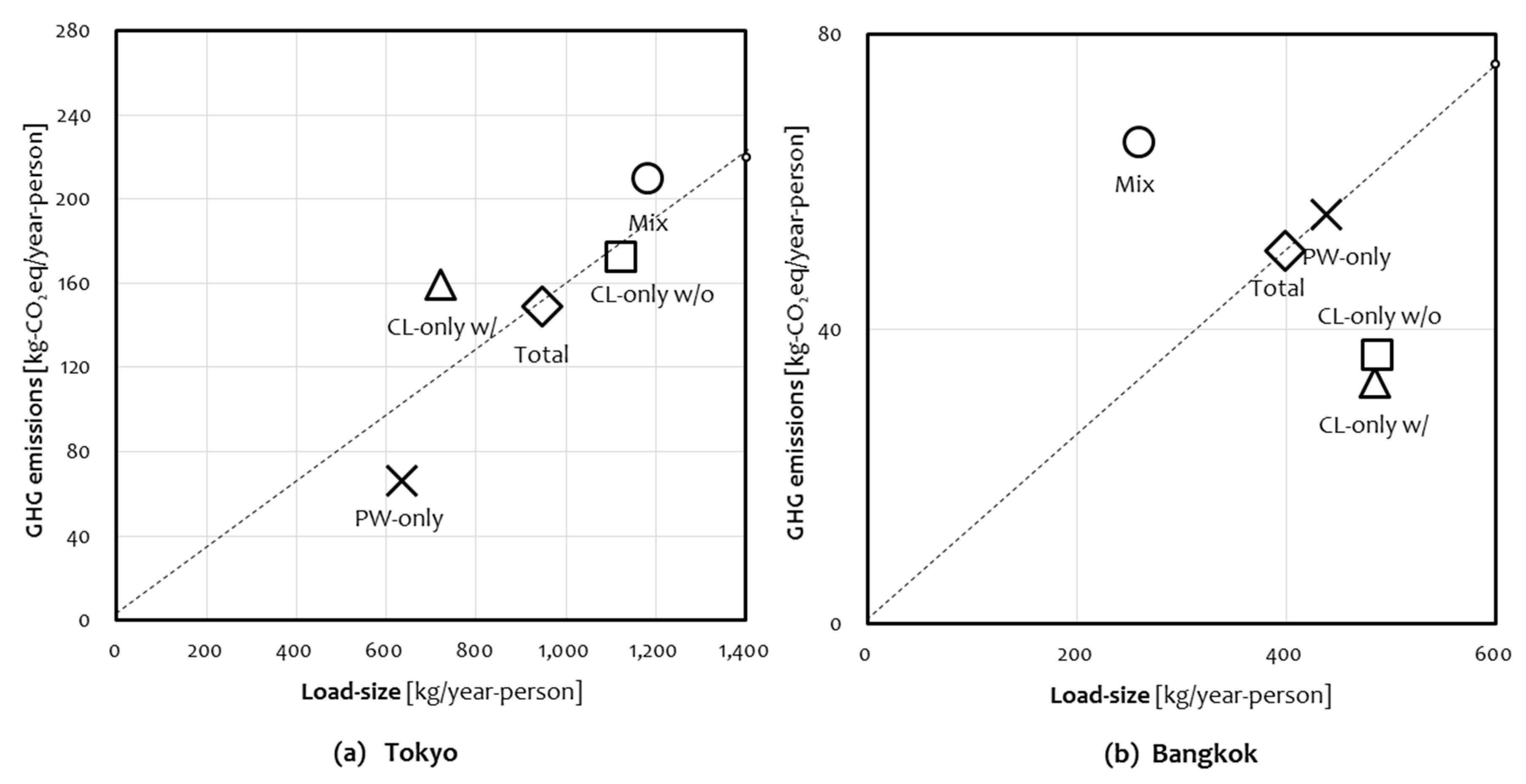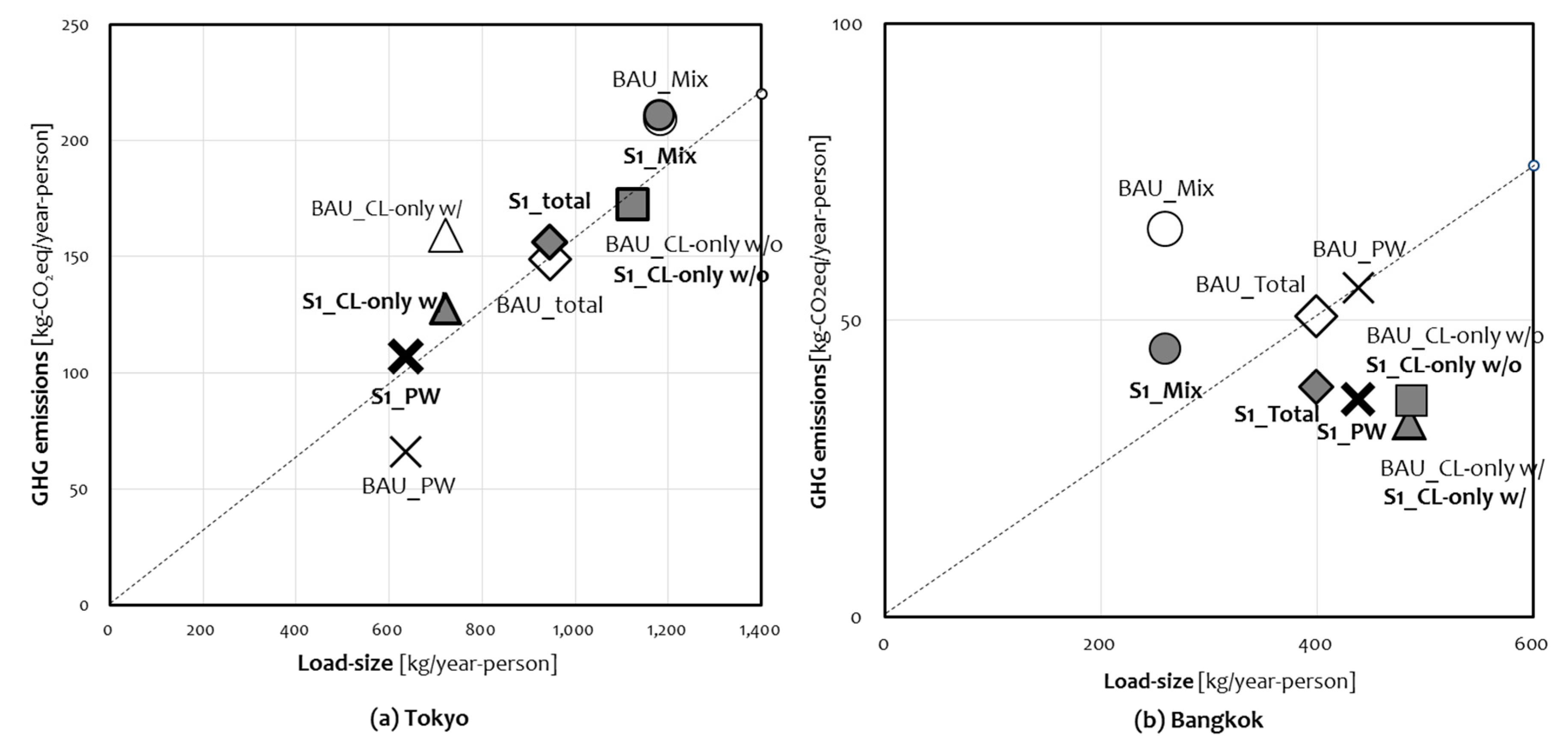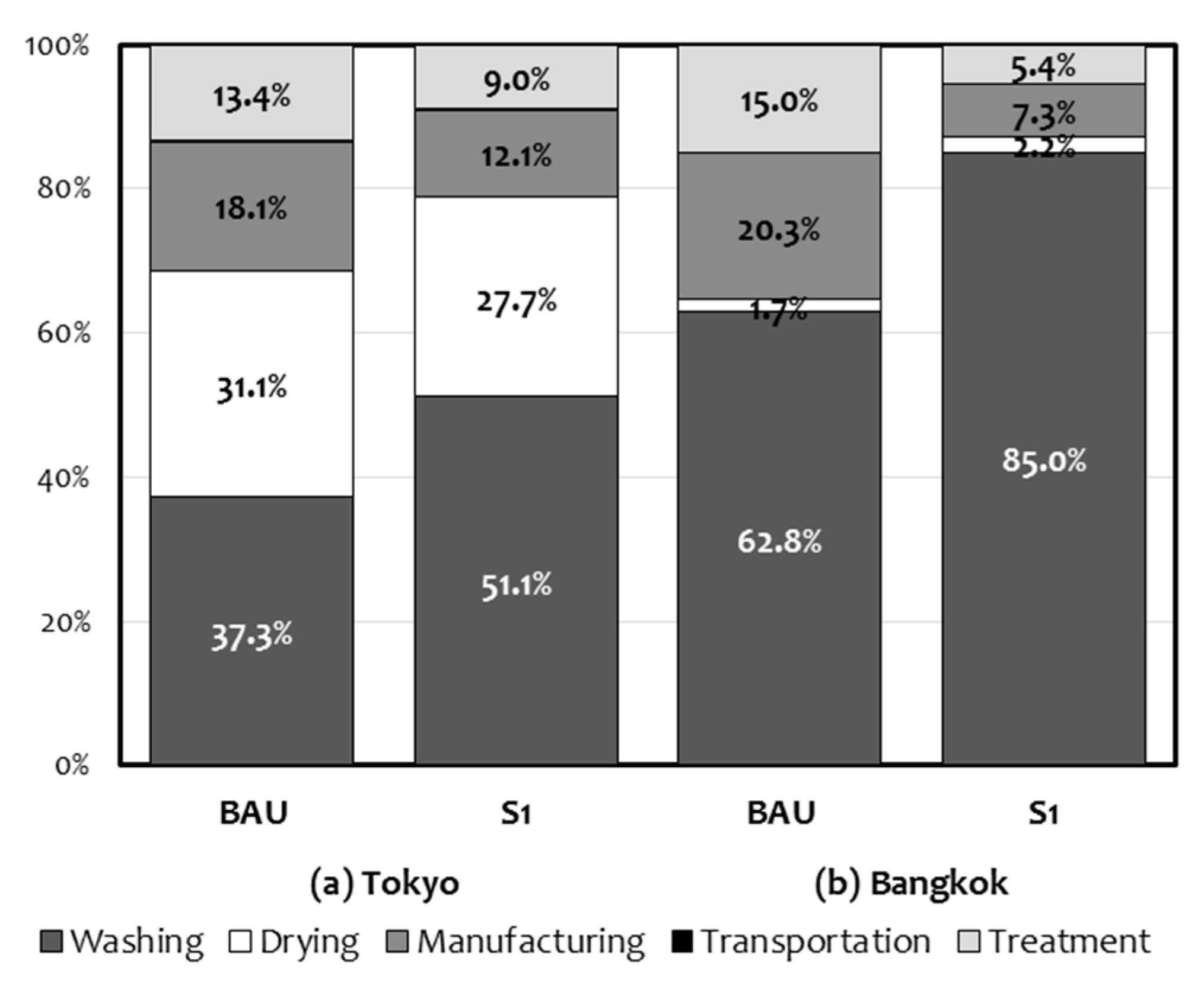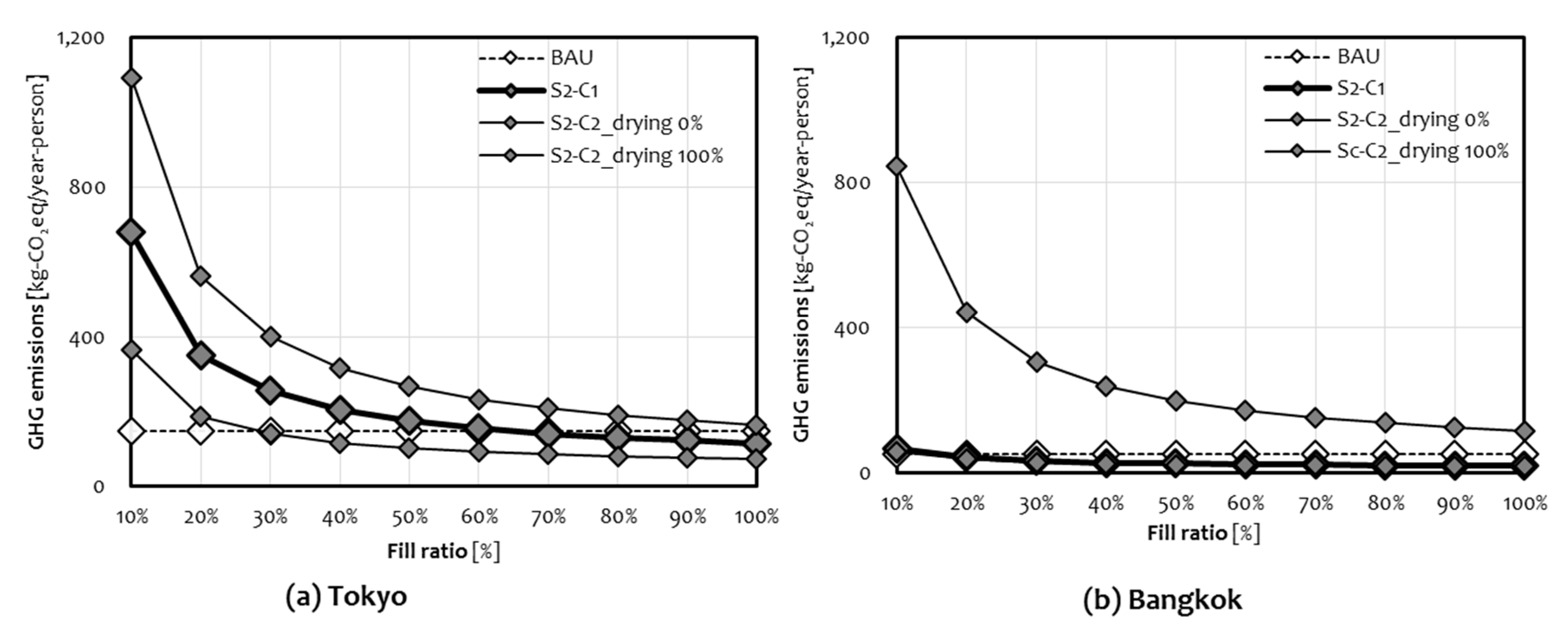1. Introduction
Laundry is a fundamental household chore. Since the invention of laundry machines (LMs), such as washers and tumble-dryers, they have been labor-saving appliances. While LMs are convenient, laundry behavior related to LMs eventually increases the burden on the environment. Therefore, it is crucial that we understand how to use LMs sustainably.
Many studies have been conducted to investigate the impact of technological improvements in LMs on accelerating sustainable laundry practices. Supplying energy-efficient washing machines is one method to reduce environmental load. For example, Stamminger et al. and Yamaguchi et al. evaluated different types of LMs and noted that replacing old products with energy-saving LMs could reduce energy consumption [
1,
2]. Similarly, Golden et al. and Lin and Iyer assessed the effect of various LM technologies, such as the Japanese impeller type (vertical-axis loader), European drum type (horizontal-axis loader), and American agitator type (vertical-axis loader), on energy and water use [
3,
4]. They concluded that consumers’ technology choices (considering individual lifestyles and cultural practices) could improve the energy efficiency of LMs and thus affect the environment. Considering the continuous development of new energy-efficient technologies in LMs, the quantity of energy and water consumed can be reduced [
5]. Nevertheless, the contribution of energy-efficient LMs in reducing environmental impact can also depend significantly on consumer behavior, stemming from the socio-cultural context.
Previous studies on consumer behavior highlighted the challenges in cultivating sustainable behavior by examining laundry behavior in different regions. In these studies, cultivating sustainable consumer behavior using LMs is seen from two perspectives: energy efficiency and clothing maintenance. First, Kruschwitz et al., Pakula and Stamminger, and Schmitz and Stamminger examined the possibility of optimizing energy-efficient LM usage by investigating the energy and water-saving factors and regional characteristics in laundry behavior [
6,
7,
8,
9]. Furthermore, Pakula and Stamminger found that 50% of energy consumption and 30% of water use can be reduced in the laundry process by increasing the load-size, decreasing the water temperature and frequency, and improving the energy and water efficiency of LMs [
8]. Second, Jack, Laitala et al., and Miilunpalo and Räisänen suggested that consumers can shift their laundry behaviors in a sustainable direction while still maintaining the cleanliness established by social norms and values [
10,
11,
12,
13]. In these studies, LM usage factors, such as water temperature, detergent dosage, loading amount, and frequency, determined the laundry behavior characteristics by region. Moreover, these factors were used to present directions to increase consumer awareness about sustainable laundry behavior, such as what to launder, when to launder, and how to launder [
14,
15,
16]. However, these studies were based on the premise that laundry behaviors are exhibited when people are using their own LMs (private ownership). Laundry behavior based on private ownership has limited potential to reduce the environmental burden because a fixed amount of resources and energy is required to make products that support individual ownership. Recently, research has emphasized the necessity of a new business structure, that is, a sharing economy, as an alternative to private ownership.
A sharing economy is regarded as an enabling system that promotes pro-environmental behavior by improving the efficiency of product usage through product-sharing [
17,
18,
19]. Recent studies on LM-sharing have also examined the potential of energy-saving effects [
20,
21,
22,
23]. For instance, Haapala et al. found that laundry services, one of the offshoots of LM-sharing, could reduce the environmental impact of home-based clothes washing by almost 50%, despite a ten-fold increase in laundry expenditure [
21]. In the use of coin-operated LMs in a laundromat (CL), Amasawa et al. and Wasserbaur et al. assessed the reduction in greenhouse gas (GHG) emissions based on a model that was developed to reflect the behavioral shift from ownership of LMs to LM-sharing [
20,
23]. These studies suggest the conceptual possibility of an increase in energy and water efficiency through LM-sharing, such as decreasing LM production and increasing the laundry’s load-size. However, laundry behavior characteristics that may arise due to LM-sharing, such as changes in LM capacity and machinery drying ratio, are not reflected. As seen in previous studies on consumer behavior regarding LMs, it can be assumed that consumer behavior can vary depending on the individual’s surroundings, such as the regional context [
7,
11,
24,
25]. It is necessary to identify the current status of laundry behavior in regions where LM-sharing is prevalent, as part of the empirical verification of conceptual possibilities to propose appropriate consumption transitions tailored to regional needs. Moon et al. attempted to define the regional characteristics and environmental impact on Bangkok by identifying survey respondents’ motivations for using a private-washing machine (PW) and CL [
26]. Moreover, a detailed region-wise study of consumer behavior and environmental impacts based on the motivation for adopting LM-sharing is required [
27,
28]. It could also be possible to clarify laundry behavior characteristics and regional differences in LM-sharing.
This study aims to clarify consumer motivation impacting laundry behavior and assess the feasibility of environmentally sustainable laundry behavior through LM-sharing. It examines the conditions under which LM-sharing can reduce environmental impact when laundry behavior shifts from ownership to sharing. In particular, the Asian cities of Tokyo and Bangkok, which show different LM ownership rates, were chosen to explore the laundry behaviors related to having a PW and using CL. A consumer survey was conducted among residents in the two regions, and the survey analysis targeted single-person households in line with Tokyo’s current demographic features. Furthermore, we examined motivations and laundry behaviors for using CL in connection with regional characteristics surrounding LM-sharing. Moreover, GHG emissions were estimated to assess each region’s environmental impact through their laundry activities. Finally, a scenario analysis was conducted to evaluate the effect of using CL instead of PW, with existing laundry behaviors, on GHG emissions.
2. Theoretical Background
Understanding consumer behavior can contribute to reducing environmental impact and improving the quality of human life [
29]. Previous studies on laundry behavior have emphasized that consumer behavior is determined by consumer intentions, motivations, and complex surroundings, rather than personal preferences. Three theoretical models explain the consumer behavior process: the Fishbein-Ajzen Theory of Reasoned Action (TRA), the Motivation-Opportunities-Abilities (MOA) model, and the Needs-Opportunities-Abilities (NOA) model [
30,
31,
32]. Through these models, behavior can be defined as a movement that is exhibited in response to an intention affected by internal or external influencing factors such as attributes, norms, and control. Thus, behavior, which includes motivational intention, is different from habit, which proceeds unconsciously without being adjusted by behavioral intention [
33]. In MOA and NOA, consumer motivation is explained as an influencing factor in embodying behavioral intention [
31,
32]. According to the NOA model, consumer motivation is essential in influencing consumer behavior formation [
32]. Consumer motivation is constituted by consumer needs and opportunities originating from a regional context such as technology, economy, demography, institutions, and culture. Moreover, consumer motivation influences consumer intention and behavior, eventually affecting the environment and quality of life. A significant aspect of the NOA model theory is that it includes regional context as a defining element for the formation of consumer behaviors. Many studies that deal with consumer behavior related to energy and water consumption in everyday life (such as laundry behavior) recognize the impact of regional contexts. However, few studies have used cultural characteristics as an explanatory variable for consumer behavior [
15,
25]. Indeed, the NOA model is a pragmatic framework for describing consumer behavior and environmental impacts across countries because it takes into consideration the flow of consumer behavioral decisions through connections to the regional context, consumer motivations, and consumer behaviors. As explained above, this study demonstrated the characteristics of consumer behaviors and the environmental impact of LM-sharing by exploring consumer motivations and considering regional contexts in Tokyo and Bangkok. The NOA model, which shows the relationship between consumer behavior and behavioral motivations impacted by regional characteristics, is thus used as the theoretical framework for this study.
5. Results
5.1. Consumer Motivations for Using Laundromats, by Respondent Segment
From the survey results, the percentage of PW-only in Tokyo was 28.0%, similar to Bangkok at 27.9% (
Figure A1). Furthermore, the percentage of CL users, including Mix, CL-only w/, and CL-only w/o in Tokyo, was 72.0% of total respondents, almost identical to the 72.1% in Bangkok.
The motivation for using CL in Tokyo and Bangkok is summarized in
Figure 3. In Tokyo, “saving time and effort” and “not enough space for drying” were the most mentioned reasons at 19.1%for both. In addition, “not enough space to install machine” indicating a physical limitation of residence, and “cheapest way”, describing convenience motives, accounted for 16.7%. Simultaneously, all Bangkok respondents answered that they used CL because of “not enough space to install machine”, regardless of the group. These seem to be affected by the laundry methods of respondents who live in dormitories away from home [
18]. It can be thought that the respondents of Mix and CL-only w/o used CLs temporarily when living in Bangkok and PWs when back at home [
18].
To understand these motivations in further detail, they were divided into groups (
Figure 3). The Mix respondents mentioned “saving time and effort” as the highest motivation to use CL, followed by “washable lots of amount at once” and “cheapest way”. In comparison, CL-only w/ respondents answered, “not enough space for drying” as the highest motivations to use CL, followed by “not enough space to install machines” and “cheapest way”. Furthermore, CL-only w/o respondents answered, “not enough space to install machine”, “not enough space for drying”, and “needless of maintenance” as the highest motivations to use CL. This indicates that respondents in Tokyo sought convenience by using CL, but the types of convenience differed among the groups. The pursuit of convenience, such as saving time and effort that a PW cannot provide during the laundry process, was the most considerable motivation to use CL among the Mix group. CL-only w/, which is the group that owns PWs but use CL-only, prioritize the convenience of the drying process.
Meanwhile, seeking the simplicity of not owning a PW was the primary motive for CL-only w/o, as well as overcoming the physical limitations. Unlike Tokyo’s results, all Bangkok residents answered “not enough space to install machine”, regardless of group. All respondents used CL as an alternative to PW because of physical limitations in living conditions (such as dormitories or other residents), which meant that LMs could not be installed [
26].
5.2. Characteristics of Laundry Behaviors
Table 2 reports the specifications of the LMs used in CLs and PWs by Tokyo and Bangkok respondents. The total average capacity of PW washers in Tokyo and Bangkok was 6.5 kg and 7.2 kg, respectively, which was similar. In contrast, the overall average capacity of CL washers in Tokyo and Bangkok was 16.3 kg and 10.4 kg, respectively. Tokyo respondents used washers in CLs over 2.5 times larger than those in PWs, while Bangkok respondents used washers with 1.4 times the capacity in the CLs than those in PWs.
The V-axis type was the most commonly used PW machine in both Tokyo and Bangkok, at 78.8% and 62.5%, respectively. The remaining 21.1% of Tokyo respondents used the H-axis type. Meanwhile, 25.0% of Bangkok respondents used the H-axis type, and 12.5% used the twin-tub type. Tokyo respondents used the H-axis type in the CL, while Bangkok respondents used all three types in the CL. This means that Tokyo respondents used different machine types between PWs and CLs, while there was not much difference between the two from Bangkok respondents.
The characteristics of laundry behaviors exhibited by the Tokyo and Bangkok respondents are reported in
Table 3. The total average load-size in Tokyo was 945.7 kg/year-person, nearly 2.5 times higher than that in Bangkok (399.2 kg/year-person). By contrast, the average number of wash-cycles in Tokyo was 116.7 wash-cycle/year, less than 32% of those in Bangkok by 169.4 wash-cycles/year. Therefore, the volume per wash-cycle among Tokyo respondents was 9.4 kg, which was more than 2.4 times the volume per wash-cycle of Bangkok respondents (4 kg).
Dividing the results into groups, in Tokyo, the CL-only w/o group washed the most laundry at 1123.3 kg/year-person, with the lowest number of 78.0 wash-cycles/year. Accordingly, the largest volume per wash-cycle was 14.6 kg of laundry/wash-cycle-person. This indicates that respondents in the CL-only w/o group tend to do laundry in larger volumes in a single wash-cycle. In contrast, the PW-only group did the least laundry with 635.8 kg/year-person and had the second-highest wash-cycle at 127.7 wash-cycle/year. Consequently, the volume per wash-cycle was the lowest with 5.1 kg/wash-cycle-person. Meanwhile, the Mix group had the second-largest volume of laundry washed at 1182.9 kg/year and the highest wash-cycle with 183.5 wash-cycles/year. Simultaneously, the Mix group had the second smallest volume of laundry washed among all groups at 6.7 kg/wash-cycle-person.
In Bangkok, there were no significant differences in load-sizes among groups except the Mix, which had the smallest volume of laundry. The load-sizes of the PW-only, Mix, CL-only w/, and CL-only w/o groups were 438, 259.8, 484.6, and 487.6 kg/year-person, respectively. The CL-only w/o had the largest load-size among the groups, and the least frequent wash-cycle at 118.3 wash-cycle/year. It also had the second-largest volume of laundry at 5.7 kg/wash-cycle-person. The CL-only w/o group in Bangkok also exhibited the behavior of washing a large number of items at once, similar to the CL-only w/o group in Tokyo. The PW-only group had 147.4 wash-cycle/year (the second-lowest), and the volume per wash cycle was also slightly smaller than the CL-only w/o group at 4.1 kg/wash-cycle-person. Meanwhile, the Mix group washes most frequently with 236 wash-cycles/year and has the smallest volume of laundry with 1.4 kg/wash-cycle-person.
Regarding the tumble-dryer utilization rate, Tokyo respondents used 42.7% of the total wash-cycle, while Bangkok respondents used only 0.8%. Examining the use of tumble-dryers by groups, in Tokyo, CL-only w/o used 78.7% of the total wash-cycle, which was the highest rate among the groups, followed by Mix at 33.9%. Only 5.7% of the PW-only used the tumble-dryer, scoring the lowest. In Bangkok, the CL-only w/o group was the only one to use a tumble-dryer, and its utilization rate was 3.3%.
5.3. Impact of Laundry Behaviors on Greenhouse Gas Emission
The correlations between the yearly load-size of laundry and the amount of GHG emissions by groups in the two regions are shown in
Figure 4. In Tokyo, the yearly load-size of laundry in increasing order is as follows: PW-only, CL-only w/, Mix, and CL-only w/o at 635.8, 721.4, 1182.9, and 1123.3 kg/year, respectively. The amount of GHG emissions increased in the following order: PW-only, CL-only w/, CL-only w/o, and Mix, emitting 66.1, 172.1, 159.3, and 209.1 kg-CO
2eq/year-person, respectively. PW-only was the most GHG-efficient group, followed by CL-only w/o. In contrast, the Mix group was the least GHG efficient among the groups.
In Bangkok, the Mix group had the smallest laundry load-size at 259.8 kg/year-person, followed by PW-only at 438.0 kg/year-person, CL-only w/o at 484.5 kg/year-person, and CL-only w/o at 487.6 kg/year-person. Moreover, Mix had the highest amount of GHG emissions at 65.3 kg-CO2eq/year-person, followed by PW-only at 55.5 kg-CO2eq/year-person, CL-only w/o at 36.4 kg-CO2eq/year-person, and CL-only w/ at 32.7 kg-CO2eq/year-person. Thus, CL-only w/o and CL-only w/ were the most environmentally efficient groups, followed by PW-only. The Mix was the least GHG efficient, similar to Tokyo.
The contribution of GHG emissions in each stage is shown in
Figure 5. In Tokyo, the GHG emissions in the washing stage were the highest, accounting for 37.3% of total GHG emissions, followed by the drying stage, at 31.1%. In Bangkok, the washing stage had the largest share of emissions overwhelmingly, accounting for 62.9%, whereas the drying stage accounted for only 1.7%. These different proportions of GHG emissions in Tokyo and Bangkok reflect typical laundry behaviors in each region, such as the number of wash-cycles and the tumble-dryer utilization rate.
Examining the results overall groups, for Tokyo, the manufacturing, transportation, and the end-of-life stages linked to producing LMs accounted for 45.5% of the total GHG amount among the PW-only group, the highest among all groups. In the CL-only w/o group, the ratio of the three stages was the lowest, accounting for only 26.2%, due to the influence of sharing LMs. In terms of the usage stage, including washing and drying, the CL-only w/o had the largest proportion among the groups, accounting for 73.8% of its total GHG amount, followed by the Mix at 68.7%, CL-only w/ at 64.4%, and PW-only as the lowest, at 54.5%. The drying stage in the CL-only w/o and Mix groups showed relatively high proportions because of the high utilization rate of the tumble-dryer, accounting for 39.7% and 34.5%, respectively.
In Bangkok, manufacturing, transportation, and end-of-life accounted for 47.4% of the total GHG amount in the PW-only group, which was the largest proportion, followed by Mix at 40.1%. However, in the CL-only w/o, these three stages were the second-lowest, accounting for 16.6% for sharing with other users, as in Tokyo. In terms of the usage stage, the CL-only w/o group had the second-largest share of GHG emissions, accounting for 83.4% of the total GHG emissions. In particular, in the CL-only w/o group (the only group that used a tumble-dryer in Bangkok), the drying stage accounted for 9.3% of total GHG emissions.
5.4. Feasibility of Environmentally Sustainable Laundry Machine Sharing: Results of Scenario Analysis
The results of the scenario analysis for the feasibility of environmentally sustainable LM-sharing were divided into two. First, the change in impact of GHG emissions by changing the respondents’ segments to CL-only w/o, comparing BAU and S1, is shown in
Figure 6.
Shifting from BAU to S1, the amount of GHG emissions in Tokyo slightly increased by 5.1%, while the emissions in Bangkok decreased by 23.5%. Based on the groups, in Tokyo, the amount of GHG emissions in the PW-only group increased sharply by 62.1%. The critical contributor to the increase of GHG emissions by the PW-only group in S1 is the change in LM capacity from PW to the use of CL by large-capacity LM. The Mix also showed an increase of 0.7% in changing their behavior from using CLs and PWs to using only CLs. However, GHG emissions in the CL-only group decreased by 19.9% by abandoning their PWs from S1. In Bangkok, the GHG decline was observed in all groups; PW-only decreased the most by 33.9%, followed by Mix with a 31.2% decrease, and CL-only w/ by 0.1%. The contribution of GHG emissions in both scenarios is shown in
Figure 7. The proportions of the three stages involved in producing LMs, such as manufacturing, transportation, and end-of-life, showed a decrease in both regions by sharing LMs with other users instead of using PWs in S1 compared to the BAU. Specifically, the proportion in the related stages in Tokyo and Bangkok declined from 31.5% to 21.2% and from 35.5% to 12.8%, respectively. In contrast, the proportion of GHG emissions at the washing stage increased in both regions. These grew from 37.3% to 51.1% and from 62.8% to 85.0% in Tokyo and Bangkok, respectively.
Second, to further analyze the GHG emissions by changing the laundry behaviors of survey respondents in addition to the segment changes, the sensitivity results of the GHG emissions in S2-C1 and S2-C2 are shown in
Figure 8.
As a result of S2-C1, the amount of GHG emissions decreased by 83.1% in Tokyo and by 69.7% in Bangkok when the fill ratio increased from 10% to 100%. At the changing point, when the amount of GHG emissions in S2-C1 decreased below the BAU level, the fill ratio was 60–70% in Tokyo and 10–20% in Bangkok. The S2-C2 results indicate the potential to reduce 10.7% and 44.8% of GHG emissions, respectively, according to changes in the fill rate in Tokyo and Bangkok, when the utilization rate of the tumble-dryer is zero. Conversely, it also shows that it is possible to increase GHG emissions to 242.7% and 539.4% in Tokyo and Bangkok, respectively, when the utilization rate reaches 100%. Therefore, it is necessary to change the fill ratio and utilization rate of tumble-dryers to realize environmentally sustainable LM-sharing.
6. Discussion
This study investigated consumer motivations and GHG emissions in the laundry process to propose environmentally sustainable laundry behaviors through LM-sharing. In this study, consumer behavioral motivation was analyzed to describe the regional characteristics of LM-sharing in Tokyo and Bangkok. Here, the relationship between consumer behavior and motivation was affected by regional contexts and was defined based on the international consumer behavioral process’s NOA model. Furthermore, this study targeted single-households to reflect current demographic features that appeared in CL-only users in Tokyo. The results can be discussed from three perspectives: the behavioral characteristics of using CL in Tokyo and Bangkok, differences in GHG emissions according to the laundry behaviors of the respondent segments, and the feasibility of environmentally sustainable LM-sharing.
First, Tokyo and Bangkok respondents had different motivations for LM-sharing: convenience and basic needs, respectively, and their differences affected GHG emissions. Tokyo is one of the cities where LMs have become necessary household items, reaching a PW ownership rate of almost 100%, according to national statistics [
37]. The regional contexts related to LM ownership were reflected in the motivation to pursue convenience-oriented laundry through LM-sharing in Tokyo. CL has been used to increase laundry efficiency, such as saving time and effort to achieve a large laundry volume at once or to dry laundry conveniently. Thus, larger capacity commercial washers and tumble-dryers were used in CL in Tokyo to pursue convenience that saves time and effort at a level PWs cannot meet (
Table A1,
Table 2 and
Table 3). Meanwhile, in Bangkok, which has a PW ownership rate of less than 60%, CL is mainly used as an alternative to PWs because of the physical limitations of installing LMs in residences [
26]. This motivation for using CLs in Bangkok was reflected in laundry behavior, with the Bangkok respondents using the CL for daily needs. Thus, in the CL, washers with similar machine types to PWs were used, while tumble-dryers were infrequently used (
Table A1,
Table 2 and
Table 3). The differences in the laundry behavior linked to motivations are ultimately affected by GHG emissions differences in both regions. Average GHG emissions of Tokyo respondents seeking convenience beyond what a PW can provide was roughly three times as large as that of Bangkok respondents seeking practicality (
Figure 4).
Second, the environmental distinction between the Mix and CL-only w/o groups was clarified. Mix respondents washed the most frequently, using both PWs and CLs to suit their requirements. Meanwhile, the CL-only w/o group could increase environmental efficiency because they tend to wash more laundry collectively and have the lowest wash-cycle among all groups. Simultaneously, it was also clarified that they use large-capacity commercial washers and tumble-dryers for laundry. It can have less environmental efficiency, even though these machines are shared with multiple users (
Table 2 and
Table 3). The differences in laundry behaviors between the two groups affect GHG efficiency. The CL-only w/o group, which used only CLs without a PW, was the second most environmentally efficient group after the PW-only. However, the Mix group, those using both PWs and CLs, was the least GHG-efficient group (
Figure 4). As LM-sharing spreads, the proportion of Mix is expected to grow more than that of CL-only w/o. The increase in Mix users seeking convenience in the laundry process could increase total GHG emissions. Therefore, clearly distinguishing the resident segment of the Mix and CL-only w/o groups is essential to suggesting environmental sustainability through LM-sharing.
Third, LM-sharing was feasible for environmental sustainability if specific laundry behaviors were observed, such as increasing laundry volume and decreasing the mechanical-dryer utilization rate (
Figure 5 and
Figure 7). Two scenarios were tested to verify the effect on GHG emissions of changing the respondents’ segments (S1,
Figure 5) and the laundry behaviors of survey respondents (S2-C1 and S2-C2,
Figure 8). As per the results of S1, where all segments changed to CL-only w/o, it was confirmed that the amount of GHG emissions could be reduced below the BAU level in Bangkok (
Figure 5). Additionally, as per the results for S2-C1 and S2-C2, further reduction in GHG emissions could be achieved by raising the fill ratio and decreasing the tumble-dryer utilization rate to zero in both regions (
Figure 8). Conversely, when the tumble-dryer utilization rate reached 100%, GHG emissions could increase dramatically. The increase in GHG due to the expansion of tumble-dryer use was particularly noticeable in Bangkok, where tumble-dryers are uncommon.
In Thailand, franchise firms open many CLs around Bangkok [
39,
48]. The franchise CLs are equipped with the latest LMs to meet the younger generation’s growing demands (
Table 1). GHG emissions can increase due to changes in the structure of LM-sharing businesses that encourage an increase in tumble-dryers in Bangkok, as evidenced by the results of the scenario analysis (
Figure 7 and
Figure 8). Furthermore, the introduction of CLs can stimulate the use of additional options in laundry behaviors, such as hand-washing for pretreatment of laundry or increased use of other kinds of laundry shops, such as dry cleaners. If consumers have the opportunity to use advanced LMs to save time and effort after their basic needs have been met, they might adopt more convenient laundry behavior. In addition to technological improvements in machines, the influence of consumer behaviors toward energy-saving and water-saving potential has to be considered [
8]. The change in the laundromat system can influence an individual’s needs and opportunities, and thus his/her laundry behavior, and eventually affect the environment. This indicates that interdependence between social and environmental impacts could emerge during the transition to a PS system [
22]. Therefore, to achieve sustainable LM-sharing, effort into production and supply in order to drive motivations to meet basic consumer needs, instead of extending consumer desires, is required.
The generalization of the analysis results may be erroneous due to the small sample size. The analysis focused on single-person households that were characteristically shown by Tokyo’s LM-sharing users. Although the number of samples was small, it was possible to clarify LM-sharing behavior by comparing with other respondents from the same demographic group of single-person households. In addition, the analysis results related to a single-person household could clarify previous studies on laundry behavior based on unclassified respondents [
3,
7,
49].
7. Conclusions
This study proposed LM-sharing as a means of achieving sustainable laundry behaviors. This study contributes to quantifying the environmental impact of LM-sharing consumer behavior through consumer survey results from Bangkok and Tokyo. This study also identified regional differences in consumer behavior by examining the behavioral motivation of LM-sharing in these two cities. Due to the influence of regional conditions associated with PW ownership, there were distinct motivations for using CLs in Tokyo and Bangkok. The differences in motivations affected GHG emissions, reflecting consumer behaviors in the two regions. In Tokyo, the group that used PWs only (PW-only) showed higher GHG efficiency than the group using CLs only (CL-only w/o) because large-capacity washers and many tumble-dryers were preferred in CLs, tailored to consumers’ convenience. In Bangkok, contrary to Tokyo’s results, PW-only had lower GHG efficiency than CL-only w/o because LMs similar to PWs were mainly used in the CLs to meet daily needs. Furthermore, regardless of region, the group using a mix of PWs and CLs (Mix) was the least GHG-efficient group because of the use of both PWs and CLs based on convenience. Nevertheless, a consumer’s transition to laundry behaviors that only use CLs, while increasing the laundry volume per wash-cycle and decreasing the tumble-dryer utilization rate, can reduce GHG emissions in both countries.
For consumption patterns, such as laundry behaviors that are vastly diverse in different regions, it is necessary to recommend models that consider regional characteristics rather than globally unified models to achieve sustainability. This study is significant in suggesting an approach to implement LM-sharing for sustainable consumption and production systems that reflect regional needs. Understanding consumer motivation surrounding laundry behavior is useful in proposing sustainable laundry processes that meet regional needs. Many business models using LM-sharing besides the CLs proposed in this research, such as LM leasing and shared LMs in apartment complexes, have been proposed. These proposals could be an alternative to sustainable LM-sharing tailored to the needs of various consumer lifestyles. To achieve sustainable laundry behaviors, detailed discussions on laundry practices can stimulate consumer lifestyles and induce significant transformations [
50]. It can also lead to discussions on how to meet the basic needs of various consumers while minimizing environmental impact [
50]. This research sheds light on consumer motivations for adopting LM-sharing by examining the link with consumer lifestyles in Tokyo and Bangkok. However, further analysis of consumer acceptance of LM-sharing in the two regions has not been conducted in this research. Moreover, since this study targeted single-person households, there are limitations on the analysis results that cannot be applied to other household types. Single-person household lifestyles have characteristics suitable for continuing consumption through sharing, and the proportion of single-person households is expected to increase in the future [
51]. Additionally, to extend the applicability of LM-sharing, further analysis is needed to include diverse household types in order to propose sustainability through LM-sharing. Moreover, additional research on consumer acceptance to practice sustainable laundry behaviors should be conducted in the future.
